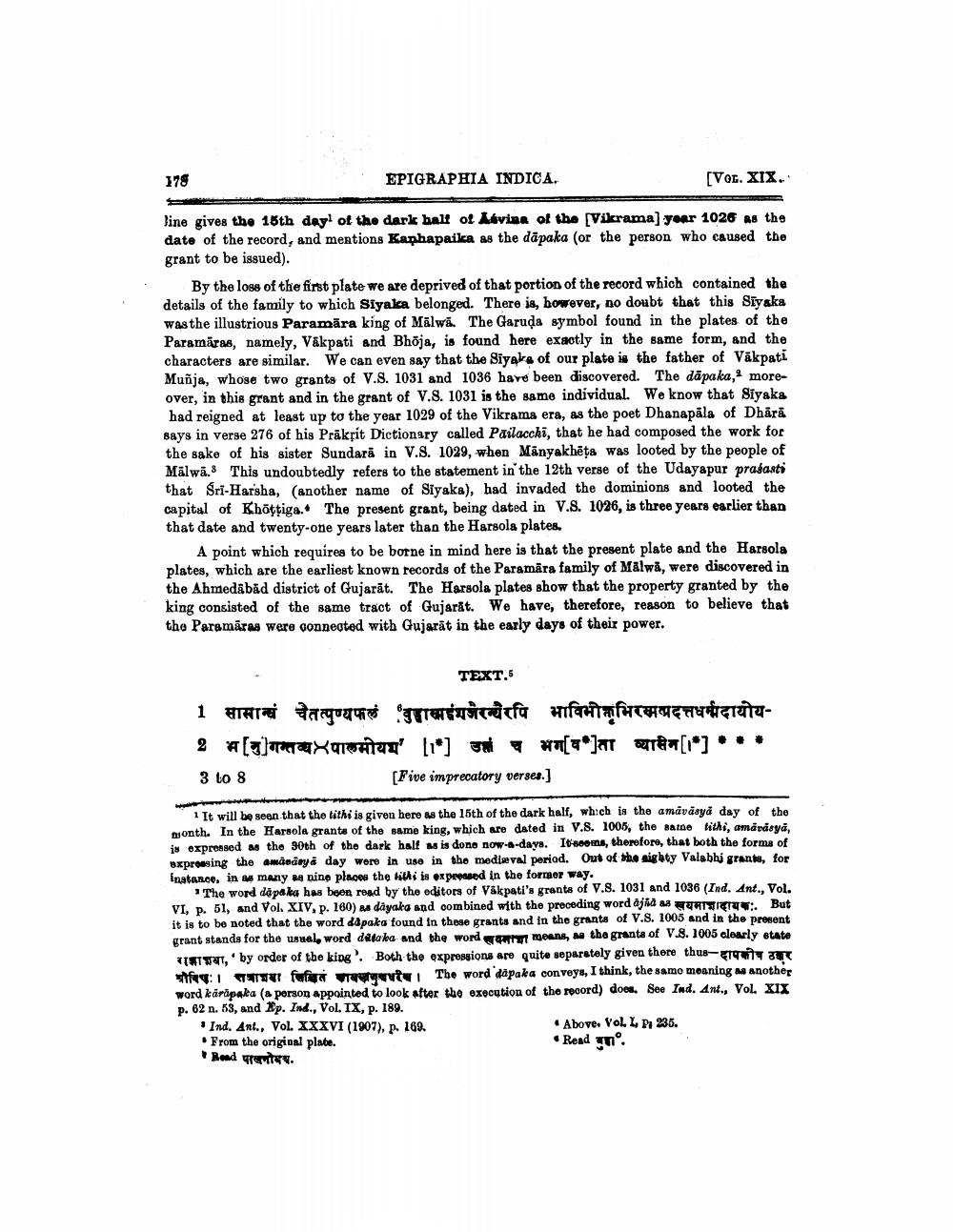________________
178
EPIGRAPHIA INDICA.
[VOL. XIX.
line gives the 18th day of the dark bolt of Livina of the Vikrama) yaar 1026 As the date of the record, and mentions Kaphapaika as the dāpaka (or the person who caused the grant to be issued).
By the loss of the first plate we are deprived of that portion of the record which contained the details of the family to which Siyaka belonged. There is, however, no doubt that this Siyaka was the illustrious Paramāra king of Malwa The Garuda symbol found in the plates of the Paramāras, namely, Väkpati and Bhõja, is found here exactly in the same form, and the characters are similar. We can even say that the Siyaka of our plate is the father of Vākpati Muñja, whose two grants of V.S. 1031 and 1036 have been discovered. The dāpaka, moreover, in this grant and in the grant of V.8. 1031 is the same individual. We know that Siyaka had reigned at least up to the year 1029 of the Vikrama era, as the poet Dhanapala of Dhårā says in verse 276 of his Präkrit Dictionary called Pailacchi, that he had composed the work for the sake of his sister Sundară in V.S. 1029, when Mänyakhēta was looted by the people of Mālwa. This undoubtedly refers to the statement in the 12th verse of the Udayapur prasasti that Sri-Harsha, (another name of Siyaka), had invaded the dominions and looted the capital of Khóttiga. The present grant, being dated in V.8. 1026, is three years earlier than that date and twenty-one years later than the Harsola plates.
A point which requires to be borne in mind here is that the present plate and the Harsola plates, which are the earliest known records of the Paramära family of Mālwå, were discovered in the Ahmedabad district of Gujarat. The Harsola plates show that the property granted by the king consisted of the same tract of Gujarat. We have, therefore, reason to believe that the Paramāras were connected with Gujarät in the early days of their power.
TEXT.5
1 सामान्वं चेतत्पुण्यफलं जामहंगजेरन्यैरपि भाविभीनृभिरमप्रदत्तधर्मदायोय2 A[i]
m XOPATAT' 11"] Jaa [**]at TÊT[l*) 3 to 8
[Five imprecatory verses.]
1 It will be seen that the tithi is given here as the 15th of the dark half, which is the amavasya day of the month. In the Harsola granta of the same king, which are dated in V.S. 1005, the same tithi, amavasya. in exprensed as the 30th of the dark hall ms is done now-a-days. Income, therefore, that both the forms of expressing the amânary a day were in use in the medieval period. Out of the nighty Valabbi grants, for Instance, in many w nino places the lithi is expressed in the former way.
The word dapaka has been road by the editors of Vákpati's grants of V.8. 1031 and 1036 (Ind. Ant., Vol. VI, p. 51, and Vol. XIV, p. 160) dayaks and combined with the preceding word ajad M WYATTIETTY. But it is to be noted that the word dipaka found in these grants and in the grants of V.8. 1005 and in the prosent grant stands for the usual, word dataka and the word means, tha granta of V.8.2005 clearly state ITWT1, by order of the king'. Both the expressions are quite separately given there thus- an i
fufer ve ut The word 'dapaka conveys, I think, the samo moaning is another word käräpaka (person appointed to look after the execution of the record) does. See Ind. Ant., Vol. XIX p. 62 n. 53, and Ep. Ind., Vol. IX, p. 189. . Ind. Art., Vol. XXXVI (1907), p. 169.
. Above. VOLL P235. . From the origioal plate.
Read yno. Rand पावनोदय.
s




